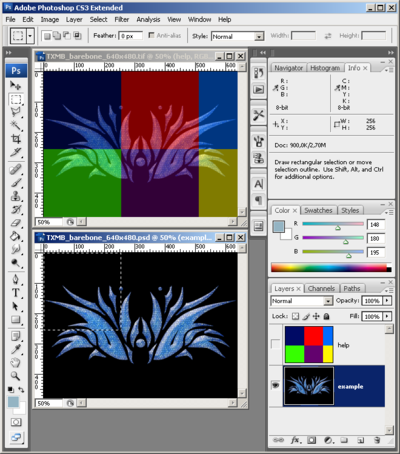XML:TXMB
| TXMB : Texture Map Big | 
| |
|---|---|---|
| XML
TRSC << Other file types >> AITR |
General information
640x480 made of ... _0 - 256x256 _1 - 256x256 _2 - 128x256 _3 - 256x224 _4 - 256x224 _5 - 128x224 +-----+-----+---+ | _0 | _1 |_2 | | | | | | | | | +---------------+ | _3 | _4 |_5 | | | | | +---------------+ |
1024x768 made of ... _0 - 256x256 _1 - 256x256 _2 - 256x256 _3 - 256x256 _4 - 256x256 _5 - 256x256 _6 - 256x256 _7 - 256x256 _8 - 256x256 _9 - 256x256 _10 - 256x256 _11 - 256x256 +-----+-----+-----+-----+ | _0 | _1 | _2 | _3 | | | | | | +-----------------+-----+ | _4 | _5 | _6 | _7 | | | | | | +-----------------+-----+ | _8 | _9 | _10 | _11 | | | | | | +-----------------+-----+ |
- The XML code on this page is compatible with OniSplit v0.9.61.0
- TXMB files create the splash screens which we see at the start and end of levels (making three total: the title screen, an endscreen for losing the level, and one for winning).
- A TXMB file simply hold links to TXMPs which are assembled by Oni to display a larger picture than the maximum size of a single texture.
The current max resolution for a single TXMP in Windows is 512x512 and on Mac is 1024x1024 as of 2018. - The arrangement of the constituent TXMPs into columns and rows is computed at runtime. Probably the engine stacks TXMPs horizontally until the value in the Width field is reached, and then starts a new row.
- TXMBs are displayed with the BSL command "splash_screen image_name". They can be called whenever we like; during their display, the game will be paused.
Example TXMB — TXMBwin_splash_screen.xml (from level1_Final/NoGlobal)
<?xml version="1.0" encoding="utf-8"?>
<Oni>
<TXMB id="0">
<Width>640</Width>
<Height>480</Height>
<Textures>
<Link>TXMPlevel01_win_0</Link>
<Link>TXMPlevel01_win_1</Link>
<Link>TXMPlevel01_win_2</Link>
<Link>TXMPlevel01_win_3</Link>
<Link>TXMPlevel01_win_4</Link>
<Link>TXMPlevel01_win_5</Link>
</Textures>
</TXMB>
</Oni>
Example TXMP -- TXMPlevel01_win_0.xml (from level1_Final/NoGlobal)
<?xml version="1.0" encoding="utf-8"?>
<Oni>
<Texture>
<Flags>DisableUWrap DisableVWrap</Flags>
<Format>BGR555</Format>
<Image>TXMPlevel01_win_0.tga</Image>
</Texture>
</Oni>
Creating a TXMB
You can use Vago to create a TXMB and its constituent TXMPs with the menu item "Tools">"Background Image Wizard".
Alternatively, you can create the files manually using the following process (this example makes a 640x480 TXMB):
- The actual work is to split the image into six smaller ones.
- You can use Photoshop, or else a TIFF should work with any other layer-supporting image editor.
- The six-part colored layer should help when the program cannot load a selection.
- Let's drag'n'drop our image into this TXMB template (.psd / .tif) and move to to the center.
- Now we can right-click, load a selection, crop and save it as "..._N" (whereas N is a number from 0 to 5).
- Let's redo crop, load another selection, save this piece, and so on.
Algorithm to split an image for TXMB
The following algorithm seems to work correctly in generating a 640x480 TXMB, the size that is used in vanilla Oni. The algorithm is currently used in Vago for TXMB creation. It works as follows:
Try to fit 256x256 images into the TXMB's space until you aren't able to add any more images of that size, then find the remaining width/height left to complete the TXMB. Example:
256x256 | 256x256 | 128x256 * 256x224 ** | 256x224 ** | 128x224* **
*We add an image of 128px width, because anything more would overflow the TXMB's 640px width.
**We add images of 224px height, because 256px height images would have overflowed the TXMB's 480px height.
Algorithm pseudo code:
function getSplitSizes(int sideSize){
vector splitSizes;
int remainingSize = sideSize;
int regularSize = 256;
while (remainingSize > 0){
if(remainingSize - regularSize < 0){
splitSizes.add(remainingSize);
remainingSize = 0;
}
else{
splitSizes.add(regularSize);
remainingSize = remainingSize - regularSize;
}
}
return splitSizes;
}
Automatically-loaded TXMBs
There are three TXMBs that Oni automatically loads by name upon specific events:
- TXMBintro_splash_screen
- Savepoint loaded
- TXMBwin_splash_screen
- Level won ("win" BSL function is called)
- TXMBfail_splash_screen
- Level failed ("lose" BSL function is called)
These files are looked for in the specific level's folder. If they are not provided, the engine simply skips them.
Reassembling a TXMP
OniSplit does not offer to extract TXMBs to a single composite image made up of the individual TXMPs. It will only extract to XML a list of the TXMP names. If you have ImageMagick installed, use this command on the TXMPs to reassemble them into one large image:
montage -mode concatenate -tile 4x TXMPlevelXX_fail_*.png TXMPlevelXX_fail.png
- The images of course need to be passed to IM in the correct order; the numerical order determined by their names will work, but only if they are named with two-digit padding (TXMPlevelXX_fail_00.png, …_01.png, etc.). Otherwise, TXMPlevelXX_fail_10.png would come right after …fail_1.png and before …fail_2.png.
- The "4" in "tile -4x" is derived from your knowing that this TXMB is 1024x1024 and the TXMPs are 256px wide, therefore the TXMB is made up of 4 columns of TXMPs.
Creating custom splash screens (similar to original game style)
ViciousReilly provided to the community the following Adobe Photoshop templates that allow any modder to create similar splash screens to the ones found in the original game:
If you use the templates above please give credit to ViciousReilly for his work!
Example of splash screen that uses the templates above (note: it includes some extra editing not present in the templates):
